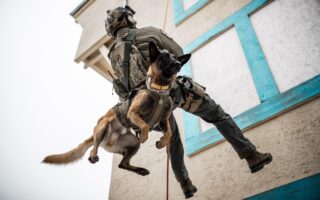Title: Mastering the Art of Blue Heeler Training: Unleashing Potential and Building Bonds
Introduction:
In the realm of canine companionship, few breeds embody the spirit of intelligence and enthusiasm quite like the Blue Heeler, or Australian Cattle Dog. With their striking blue coats and determined demeanor, these dogs are not just eye-catching; they are renowned for their incredible work ethic and boundless energy. Originally bred to assist farmers in herding cattle, Blue Heelers are as spirited as they are loyal, making them exceptional companions when properly trained. However, the journey to a well-behaved and balanced Blue Heeler is not without its challenges. This article seeks to explore effective training techniques, helping owners navigate the unique temperament and instincts of this remarkable breed. Whether you are a seasoned trainer or a first-time dog owner, understanding the nuances of Blue Heeler training is key to fostering a lasting bond and unlocking the potential of your four-legged friend. Join us as we delve into the essential strategies that can transform a spirited pup into a well-mannered member of the family.
Table of Contents
- Understanding the Blue Heeler Temperament for Effective Training
- Essential Commands for Building a Strong Foundation in Blue Heeler Training
- Enhancing Socialization Skills for a Well-Rounded Blue Heeler
- Addressing Common Behavioral Challenges in Blue Heelers Through Training
- Q&A
- To Wrap It Up
Understanding the Blue Heeler Temperament for Effective Training
The Blue Heeler, known for its intelligence and high energy levels, is a breed that thrives on mental and physical stimulation. Understanding their unique temperament is essential for effective training. These dogs are highly instinctual, meaning they possess a strong herding drive that can manifest in various behaviors. To harness this energy positively, training should incorporate activities that engage both their mind and body, such as agility courses or puzzle toys. This breed is also very loyal but can be independent, so consistent and positive reinforcement training methods are crucial for fostering a strong, cooperative bond.
Moreover, Blue Heelers are typically alert and protective, making them excellent companions but also resulting in some stubbornness during training sessions. It’s important to establish yourself as a confident and calm leader while providing clear commands to avoid confusion. Socialization plays a vital role in developing a well-rounded Blue Heeler, so exposing them to various environments, people, and other animals early on is essential. Consider using the following tips for a smoother training experience:
- Consistency: Use the same commands and cues.
- Positive Reinforcement: Reward desired behaviors with treats, praise, or play.
- Short Sessions: Keep training sessions brief but frequent to maintain their focus.
- Variety: Mix different training exercises to keep your Blue Heeler engaged.
Essential Commands for Building a Strong Foundation in Blue Heeler Training
To effectively train a Blue Heeler, it’s essential to establish a solid base of commands that promote discipline and enhance communication between you and your pup. Start with fundamental commands such as “Sit”, “Stay”, “Come”, and “Leave It”. These commands not only ensure safety in various situations but also build a trusting bond. Below are additional commands that are particularly beneficial:
- “Heel”: Teaches your dog to walk at your side.
- “Drop It”: Encourages them to release items they shouldn’t have.
- “Off”: Essential for keeping your dog off furniture or people.
- “Go to Place”: Directs your Blue Heeler to a designated spot to relax.
Incorporating consistency and positive reinforcement into your training routine will yield the best results. It’s important to maintain a calm demeanor while training, as Blue Heelers are sensitive to their owner’s emotions. To further illustrate the training process, a simple schedule can be beneficial:
| Day | Target Command | Training Duration |
|---|---|---|
| Monday | Sit | 10 mins |
| Wednesday | Stay | 10 mins |
| Friday | Come | 10 mins |
Enhancing Socialization Skills for a Well-Rounded Blue Heeler
Socialization is crucial for Blue Heelers, as their naturally energetic and intelligent demeanor thrives in diverse environments. To ensure a well-rounded dog, it’s essential to introduce them to various experiences. Start by exposing your Blue Heeler to different people, places, and other animals slowly and safely. Activities such as visiting parks, attending dog-friendly events, or joining training classes can provide enriching opportunities for interaction. Here are a few suggested activities to enhance their social skills:
- Meet New People: Organize playdates with friends and family.
- Dog Parks: Allow your Blue Heeler to mingle with other dogs.
- Obedience Classes: Exposure to structured social settings enhances discipline.
- Outdoor Adventures: Hike in different locations to meet various hikers and pets.
Another aspect of effective socialization is positive reinforcement. Rewarding your Blue Heeler for calm behavior in new scenarios can significantly impact their confidence and adaptability. Keep in mind that consistency is vital; regular social experiences will help your dog develop good habits over time. You can track their progress by maintaining a simple table, noting their reactions and improvements after each outing:
| Activity | Reaction/Behavior | Improvements Noted |
|---|---|---|
| Visit to the dog park | Playful with other dogs | More confident during interactions |
| Obedience Class | Focused on commands | Increased attention to owner |
| Family Gathering | Sociable with strangers | Improved comfort with unfamiliar people |
Addressing Common Behavioral Challenges in Blue Heelers Through Training
Blue Heelers, known for their intelligence and energy, can sometimes exhibit behavioral challenges that may arise if not properly trained. Common issues such as excessive barking, jumping, or stubbornness can be addressed through consistent and positive reinforcement training methods. It’s essential to establish clear goals and utilize engaging training sessions that captivate their attentive nature. Techniques such as the following can be beneficial:
- Positive reinforcement: Reward desired behaviors with treats or praise.
- Consistency: Use the same commands and cues to avoid confusion.
- Structured playtime: Incorporate play as a reward to reinforce learning.
An effective training regimen should also focus on socialization to prevent behavioral challenges stemming from fear or aggression. Exposing your Blue Heeler to various environments, people, and other animals can help them learn appropriate responses in different situations. Consider implementing structured socialization schedules that may include:
| Activity | Frequency | Duration |
|---|---|---|
| Group training classes | Weekly | 1 hour |
| Playdates with other dogs | Bi-weekly | 2 hours |
| Public outings | As needed | 1-2 hours |
By addressing these behavioral challenges with patience and determination, your Blue Heeler can thrive and develop into a well-mannered companion, ready to take on the adventures you share together.
Q&A
Q&A on Blue Heeler Training
Q1: What makes Blue Heelers unique as a breed when it comes to training?
A1: Blue Heelers, also known as Australian Cattle Dogs, are renowned for their intelligence, agility, and strong work ethic. These traits make them exceptionally trainable but also require a handler who can keep up with their energy and mental stimulation needs. Their herding instincts might lead them to take initiative, so they thrive in environments where training is consistently reinforced, and they have a purpose.
Q2: What is the best age to start training a Blue Heeler?
A2: Training can begin as early as eight weeks old. Starting with basic obedience and socialization is crucial during this developmental phase. Early exposure to various environments, people, and other animals can help them grow into well-rounded adult dogs. Consistent training throughout their formative months is vital to establish good habits and curb any undesirable behaviors.
Q3: Can you recommend some effective training techniques for Blue Heelers?
A3: Positive reinforcement is key when training a Blue Heeler. Reward-based training using treats, praise, or toys works wonders to motivate this breed. Consistency is essential; ensure commands, rewards, and expectations are the same for every training session. Incorporating agility exercises can also keep their minds sharp and help release pent-up energy. varying training exercises can keep them engaged and prevent boredom.
Q4: How important is socialization, and what are the best ways to socialize a Blue Heeler?
A4: Socialization is extremely important for Blue Heelers because it helps them comfortably interact with various stimuli. To effectively socialize your Blue Heeler, expose them to different environments, people, and situations, such as parks, pet stores, or puppy classes. Encourage positive interactions and always supervise these experiences. This early exposure can mitigate behavioral issues in adulthood.
Q5: What common behavioral challenges should one expect during Blue Heeler training, and how can they be managed?
A5: Blue Heelers may exhibit behaviors such as herding tendencies, excessive barking, or stubbornness if not correctly trained. To manage these behaviors, it’s essential to provide outlets for their energy, such as playtime and activities that engage their herding instincts, like fetch. Training sessions should be varied and mentally stimulating to prevent boredom. If challenges arise, consulting a professional trainer who understands the breed can offer tailored strategies.
Q6: How can owners ensure their Blue Heeler remains engaged and mentally stimulated?
A6: To keep a Blue Heeler mentally stimulated, it’s crucial to incorporate a variety of activities into their routine. Puzzle toys, scent games, and interactive training sessions can provide meaningful challenges. Additionally, agility training or obedience competitions can give them a sense of purpose while allowing them to expend energy. The key is to ensure their daily routine is both physically and mentally fulfilling.
Q7: Are there specific commands that Blue Heelers excel at learning?
A7: Blue Heelers typically excel at learning commands that involve movement and direction, such as “come,” “stay,” “heel,” and “fetch.” Their herding background means they often respond well to commands that facilitate control and direction. Some owners find that teaching them specific tasks, like setting boundaries or doing tricks, can also be beneficial, as it taps into their eager-to-please nature.
Q8: How can an owner strengthen their bond with their Blue Heeler through training?
A8: Training is an excellent way to build a strong bond with your Blue Heeler. Engage in regular, positive training sessions where you both share fun and success. Incorporate playtime into training, and be sure to celebrate achievements, no matter how small. Spending time together—whether training, playing, or cuddling—will enhance mutual trust and strengthen your relationship.
By understanding the unique characteristics and training needs of Blue Heelers, owners can foster a loving, well-behaved companion that thrives on collaboration and activity.
To Wrap It Up
training a Blue Heeler is not just about mastering commands; it’s about forging a lasting bond built on trust, respect, and understanding. These intelligent and energetic dogs thrive when challenged both mentally and physically, making consistent training a rewarding journey for both you and your furry companion. As you embark on this adventure, remember to infuse patience and positivity into every session, celebrating small victories along the way. With dedication and the right approach, you’ll unlock the full potential of your Blue Heeler, transforming them into a well-mannered partner ready to tackle life’s challenges by your side. So, grab those training treats and let the adventure begin—your extraordinary journey with your Blue Heeler awaits!



